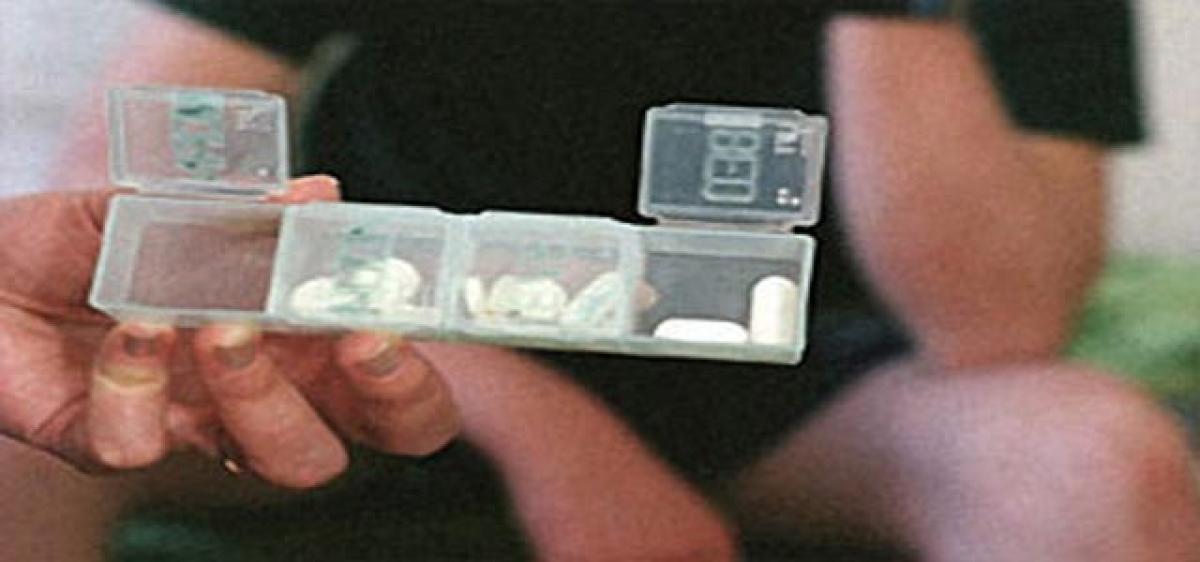Live
- Educational Trips in South Kanara Put on Hold Following Murudeshwar Drowning Incident
- Karnataka Temple Embraces Mechanical Elephant for Cruelty-Free Ceremonies
- Temple modelled after Ram Mandir to be constructed in US
- Property dealer shot dead in broad daylight in Ranchi
- Maharashtra: CM Fadnavis expands Cabinet; inducts 39 ministers
- Winter Session of UP Assembly from Dec 16; CM seeks cooperation of all parties
- AIADMK executive council meet passes sixteen resolutions, vows to make Edappadi CM again
- Manchu Family Feud Resurfaces in Jalpally
- Kerala Hindu leader gifts Rig Veda to Pope Francis
- 35 miners trapped under rubble in Afghanistan
Just In

Each of an estimated 2.1 million Indians infected with the human immunodeficiency virus (HIV) should be getting a cocktail of drugs to prolong their lives and reduce infections, but no more than 44 per cent do, the Minister of Health told the Lok Sabha in April 2016.
Each of an estimated 2.1 million Indians infected with the human immunodeficiency virus (HIV) should be getting a cocktail of drugs to prolong their lives and reduce infections, but no more than 44 per cent do, the Minister of Health told the Lok Sabha in April 2016. In India, the drug cocktail is given to patients with a count of less than 350 CD4 cells per mm3 of blood – CD4 cells are white blood cells, a count of which indicates the health of a person's immune system.
The Health Ministry said 9,40,000 (70 per cent) of 1.3 million HIV-infected patients with a CD4 count less than 350 are on anti-retroviral therapy (ART). The situation is worse among children, with no more than 36 per cent getting ART. ART are drugs that – when taken in combination – can stop the HIV virus from growing, slowing the disease. They do not kill or cure the virus.
A World Health Organisation (WHO) guideline says everyone with HIV should get ART drugs, regardless of their clinical stage and a white-blood-cell tally that India uses to determine who will be treated. An early start to ART is associated with reduced mortality, morbidity and HIV transmission outcomes, according to the WHO.
Evidence suggests that "untreated HIV infection may be associated with the development of several non-AIDS defining conditions (including cardiovascular disease, kidney disease, liver disease, several types of cancer and neurocognitive disorders) and that initiating ART earlier reduces such events and improves survivals," according to the WHO.
Chances of getting these diseases fell 57 per cent among HIV-positive patients treated early, according to a study called the Strategic Timing of Antiretroviral Treatment, conducted among more than 4,500 people across 35 different countries, between 2011 and 2016, by the International Network for Strategic Initiatives in Global HIV Trials, a US-government-funded research organisation.
There are more than 1,38,000 children (age less than 15 years old) with HIV in India, 6.5 per cent of the AIDS population. Only 36 per cent of them (50,000) are on ART drugs, a smaller proportion than the overall Indian population on ART (44 per cent). "Infants and young children living with HIV have an exceptionally high risk of poor outcomes, with up to 52 per cent of children born and living with HIV dying before the age of two years in the absence of any intervention," said the WHO. "By five years of age, the risk of mortality and disease progression in the absence of treatment falls to rates similar to those of young adult."
There are 455 ART centres nationwide, according to the same government data. Maharashtra leads with 68 centres, followed by Karnataka with 63, Andhra Pradesh with 55 and Tamil Nadu with 51. Each ART centre in Arunachal Pradesh and Sikkim caters to less than 1,000 HIV-positive patients; Haryana has a centre for every 22,500 patients. There is an ART centre for every 4,552 HIV-positive patients in India.
More than 37 million live with AIDS – the syndrome due to HIV virus – across the world, a 10 per cent increase from 2010. Globally, access to ART has increased 126 per cent over five years to 2015: 17 million more people are on ART compared to 2010. "The world has committed to ending the HIV epidemic by 2050," said a 2015 UNAIDS statement. "Expanding ART to all people living with HIV would avert 21 million AIDS-related deaths and 28 million new infections by 2030." (In arrangement with IndiaSpend.org)
By Silvio Grocchetti

© 2024 Hyderabad Media House Limited/The Hans India. All rights reserved. Powered by hocalwire.com







